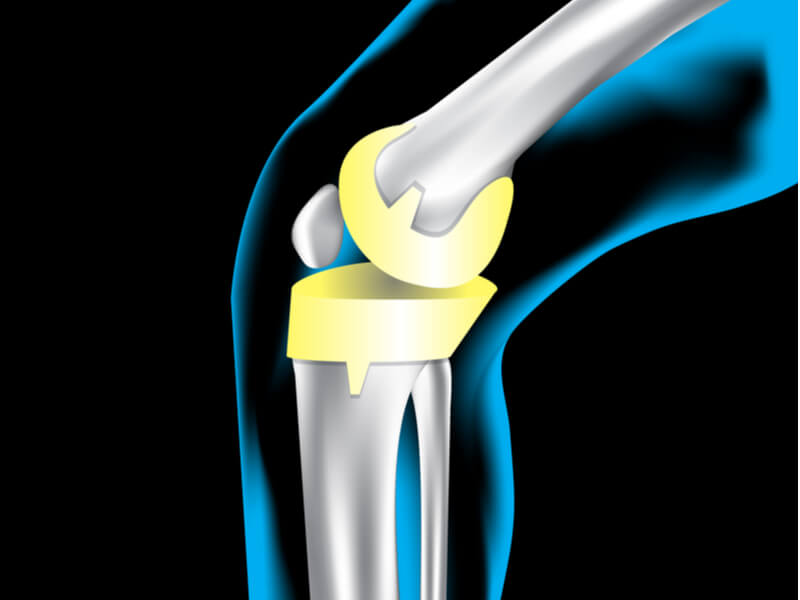
Artificial joint surgery is surgery to remove the surface of the joint that has been damaged and deformed due to osteoarthritis, rheumatoid arthritis, or trauma and replace it with an artificial joint.
It is performed on shoulders, elbows, fingers, knees, feet and various joints.
Among them, total knee arthroplasty is surgery to replace the knee joint with an artificial joint.total knee arthroplastyI will explain about.
table of contents
■ What is an artificial joint?
An artificial joint consists of three parts, the femur, the tibia, and the patella, in order to reproduce the smooth movement of the joint.
The main body of the femur and tibia is made of metal, but the upper surface of the tibia and the surface of the patella are made of durable, hard polyethylene that replaces cartilage.
Artificial joints started in the late 1800s using celluloid, silver, zinc, ivory, joint capsules, etc., and full-scale clinical application of artificial joints using metal began in the 1950s.
The artificial joint used depends on the degree of injury.
If the degree of injury is relatively light, only the surface of the bone is scraped to replace it. Become.
At the beginning of development, artificial joints sometimes broke in a short period of time, but now they are made of long-lasting metal, polyethylene, ceramic, etc., and can be used for a long time.
■ Flow of total knee arthroplasty
Knee replacement surgery involves removing the damaged bone from the diseased knee joint and fixing a replacement artificial joint.
In contrast to total knee replacement, which replaces the entire knee joint with an artificial joint, partial replacement replaces only the damaged side of the knee joint with an artificial joint, and only the cartilage on one side of the joint is worn away, and the other side is not worn out. If the damage is relatively early, such as when there is little damage, it is targeted.
Because partial arthroplasty uses a prosthesis that is about half the size of a normal prosthesis, it generally requires less skin incision and less bone resection.
Not all patients are suitable forIn recent years, minimally invasive surgery, which attempts to reduce the burden on the patient's body by making the wound as small as possible, is sometimes performed.
Surgery methods are also gradually advancing, and efforts are being made to realize patient-friendly surgeries by preserving muscles without cutting them.
■ Indications for total knee arthroplasty
Knee replacement surgery is for patients with osteoarthritis or rheumatoid arthritis, whose joints are destroyed, unstable, or contractures that interfere with daily life.
In the case of partial replacement, the following conditions must also be considered.
・You can straighten your knees
・The degree of bow legs and cross legs is light
Pain only on the inside or outside of the knee
・Not rheumatoid arthritis
・No severe obesity
No abnormalities in the knee ligaments
Recently, the long-term use of artificial joints has become possible, and the indications are expanding not only for the elderly but also for relatively young people.
Partial replacement surgery may not be possible depending on the condition and symptoms of the patient. If you wish to have partial knee arthroplasty, you should fully discuss the indications, benefits, and risks with your doctor.
■ Statistical data on total knee arthroplasty
Total knee arthroplasty has been performed in Japan for over 40 years.
It has been established as a common treatment method in orthopedic surgery, and the number of surgeries is increasing year by year, and now exceeds 90,000 per year. In addition, a stable success rate of over 90% has been reported even for long-term use of 15 years or more after surgery, and the number of surgeries in Japan is increasing steadily.
In addition, according to data published by the Ministry of Health, Labor and Welfare, the average age of patients undergoing total knee replacement surgery is 75 years old, indicating that relatively elderly people are undergoing surgery.
*Ministry of Health, Labor and Welfare 4th NDB Open Data (Receipt information, specific health checkup information database)
April 2017-March 2018 medical treatment
■ Effects and complications of total knee arthroplasty
Total knee arthroplasty is a surgical procedure that restores joint function by removing the painful part of the knee joint and replacing the highly damaged joint surface with an artificial material such as metal or polyethylene.
Replacing it with an artificial joint can be expected to be effective in reducing knee pain and improving joint function.
In addition, pain disappears early after surgery, and walking becomes smoother. Improvements in muscle strength and movement speed are recognized, and the quality of life improves dramatically. The range of motion of joints can also be acquired within a range that does not cause inconvenience in daily life.
Postoperative complications such as infection, deep vein thrombosis, pulmonary thromboembolism, and fractures may occur, but it is basically a safe operation and can be expected to be highly effective.
By all means, please consult with your doctor and enjoy the benefits of total knee arthroplasty.
* In addition to the article, the text of the Japanese Society for Artificial Joints (What is an artificial joint | The Japanese Society for Artificial Joints (jsra.info)) is used as a reference.
Supervision: Dr. Yasushi Tsuda
